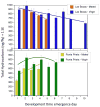Preadult life history variation determines adult transcriptome expression
- PMID: 26615085
- PMCID: PMC4738099
- DOI: 10.1111/mec.13505
Preadult life history variation determines adult transcriptome expression
Abstract
Preadult determinants of adult fitness and behaviour have been documented in a variety of organisms with complex life cycles, but little is known about expression patterns of genes underlying these adult traits. We explored the effects of differences in egg-to-adult development time on adult transcriptome and cuticular hydrocarbon variation in order to understand the nature of the genetic correlation between preadult development time and premating isolation between populations of Drosophila mojavensis reared in different host cactus environments. Transcriptome variation was analysed separately in flies reared on each host and revealed that hundreds of genes in adults were differentially expressed (FDR P < 0.05) due to development time differences. For flies reared on pitaya agria cactus, longer preadult development times caused increased expression of genes in adults enriched for ribosome production, protein metabolism, chromatin remodelling and regulation of alternate splicing and transcription. Baja California flies reared on organ pipe cactus showed fewer differentially expressed genes in adults due to longer preadult development time, but these were enriched for ATP synthesis and the TCA cycle. Mainland flies reared on organ pipe cactus with shorter development times showed increased transcription of genes enriched for mitochondria and energy production, protein synthesis and glucose metabolism: adults with longer development times had increased expression of genes enriched for adult life span, cuticle proteins and ion binding, although most differentially expressed genes were unannotated. Differences due to population, sex, mating status and their interactions were also assessed. Adult cuticular hydrocarbon profiles also showed shifts due to egg-to-adult development time and were influenced by population and mating status. These results help to explain why preadult life history variation determines subsequent expression of the adult transcriptome along with traits involved with reproductive isolation and revealed previously undocumented connections between genetic and environmental influences over the entire life cycle in this desert insect.
Keywords: cactus; cuticular hydrocarbons; development time; gene expression; life cycle; microarrays; transcriptome.
© 2015 John Wiley & Sons Ltd.
Figures


Similar articles
-
Effects of temperature on transcriptome and cuticular hydrocarbon expression in ecologically differentiated populations of desert Drosophila.Ecol Evol. 2016 Dec 20;7(2):619-637. doi: 10.1002/ece3.2653. eCollection 2017 Jan. Ecol Evol. 2016. PMID: 28116058 Free PMC article.
-
Genetics of incipient speciation in Drosophila mojavensis. III. Life-history divergence in allopatry and reproductive isolation.Evolution. 2010 Dec;64(12):3549-69. doi: 10.1111/j.1558-5646.2010.01096.x. Evolution. 2010. PMID: 20681983
-
Genetics of incipient speciation in Drosophila mojavensis: II. Host plants and mating status influence cuticular hydrocarbon QTL expression and G x E interactions.Evolution. 2009 Jul;63(7):1712-30. doi: 10.1111/j.1558-5646.2009.00661.x. Epub 2009 Feb 18. Evolution. 2009. PMID: 19228188
-
No boundaries: genomes, organisms, and ecological interactions responsible for divergence and reproductive isolation.J Hered. 2014;105 Suppl 1(Suppl 1):756-70. doi: 10.1093/jhered/esu039. J Hered. 2014. PMID: 25149252 Free PMC article. Review.
-
Ecological genomics of host shifts in Drosophila mojavensis.Adv Exp Med Biol. 2014;781:233-47. doi: 10.1007/978-94-007-7347-9_12. Adv Exp Med Biol. 2014. PMID: 24277303 Review.
Cited by
-
Manipulation of natal host modifies adult reproductive behaviour in the butterfly Heliconius charithonia.Proc Biol Sci. 2019 Sep 11;286(1910):20191225. doi: 10.1098/rspb.2019.1225. Epub 2019 Sep 11. Proc Biol Sci. 2019. PMID: 31506053 Free PMC article.
-
Relating past and present diet to phenotypic and transcriptomic variation in the fruit fly.BMC Genomics. 2017 Aug 22;18(1):640. doi: 10.1186/s12864-017-3968-z. BMC Genomics. 2017. PMID: 28830340 Free PMC article.
-
Effects of temperature on transcriptome and cuticular hydrocarbon expression in ecologically differentiated populations of desert Drosophila.Ecol Evol. 2016 Dec 20;7(2):619-637. doi: 10.1002/ece3.2653. eCollection 2017 Jan. Ecol Evol. 2016. PMID: 28116058 Free PMC article.
References
-
- Aguila JR, Suszko J, Gibbs AG, Hoshizaki DK. The role of larval fat cells in adult Drosophila melanogaster. Journal of Experimental Biology. 2007;210:956–963. - PubMed
-
- Alcorn SM, Orum TV, Steigerwalt AG, et al. Taxonomy and pathogenicity of Erwinia cacticida sp. nov. International Journal of Systematic Bacteriology. 1991;41:197–212. - PubMed
-
- Allison D, Gadbury G, Heo M, et al. A mixture model approach for the analysis of microarray gene expression data. Computational Statistics and Data Analysis. 2002;39:1–20.
-
- Barbour M, Keeler-Wolf T, Schoenherr AA. Terrestrial Vegetation of California. 3. University of California Press; Berkeley, CA: 2007.
Publication types
MeSH terms
Grants and funding
LinkOut - more resources
Full Text Sources
Other Literature Sources
Molecular Biology Databases

